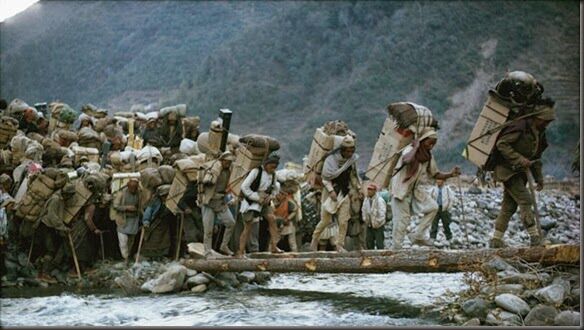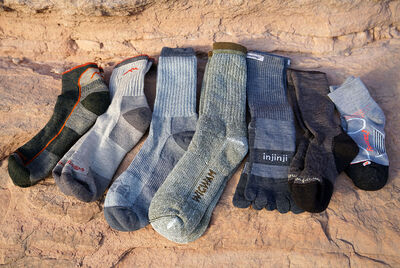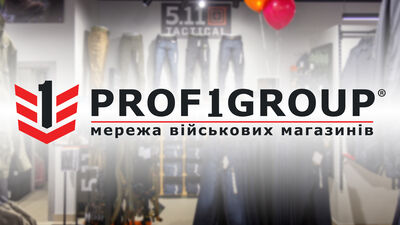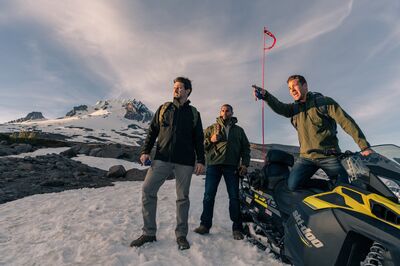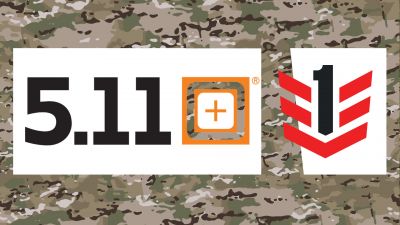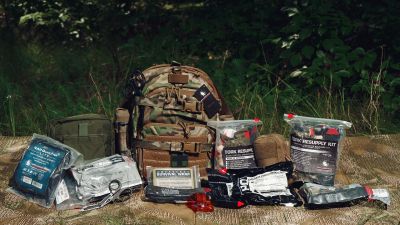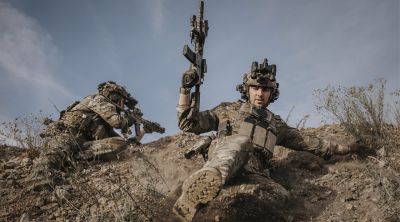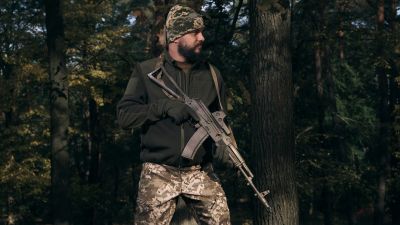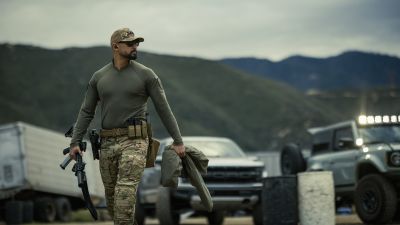Types of backpacks. How to choose a backpack.
History of creation, types and features of backpacks.
Backpack is probably the oldest element of human equipment. Even having outerwear and shoes is made of animal leather and fur, a man in any way needed a prototype of a bag. This is an indispensable thing in the era of great migrations and nomadic lifestyle.
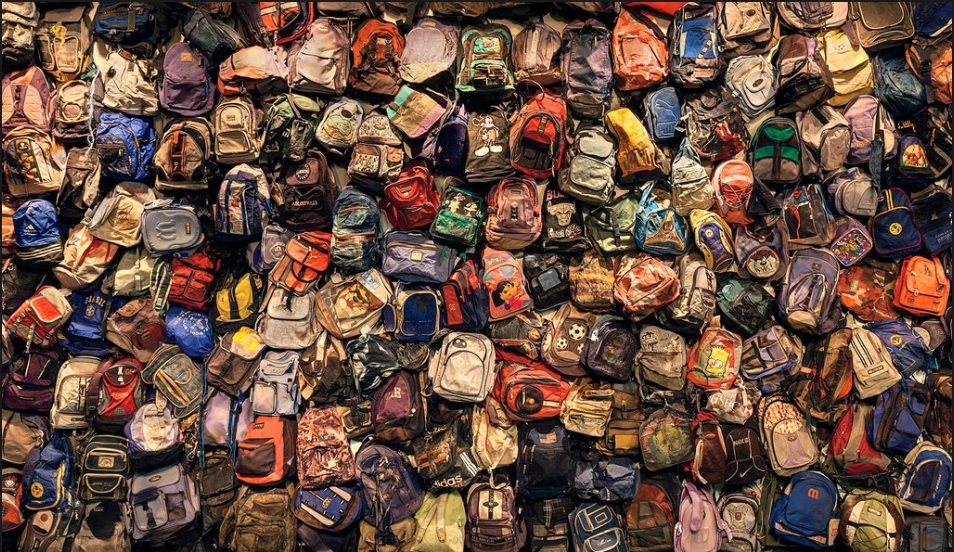 Photo by Richard Barnes for The New York Times.
Photo by Richard Barnes for The New York Times.
History of creation of the first rucksacks.
Antiquities.
Innovators in this field were Roman legionaries. Already at the beginning of the 1st century A.D. they were equipped with the so-called pole-fursa. It was a wooden stick, which was placed on the shoulder – one side of the legionaries held in his hand, the other side was attached to a sack with personal belongings, and other equipment. This allowed the soldiers to quickly get rid of such a sack if necessary on the battlefield, obviously – these are the first bags of clothing, entered into mass production and use. At the same time, the cavalry began to appear the first saddlebags in, due to the peculiarities of use were more practical and wider in scope.
Middle Ages.
The turning point was the creation of the first shoulder bag with one and two straps, which increased ergonomics and versatility in use. It is hard to say where and by whom exactly it was designed for the first time – the findings of archaeologists indicate that such bags were used by people from ancient times, but the mass phenomenon has acquired it in the late Middle Ages.
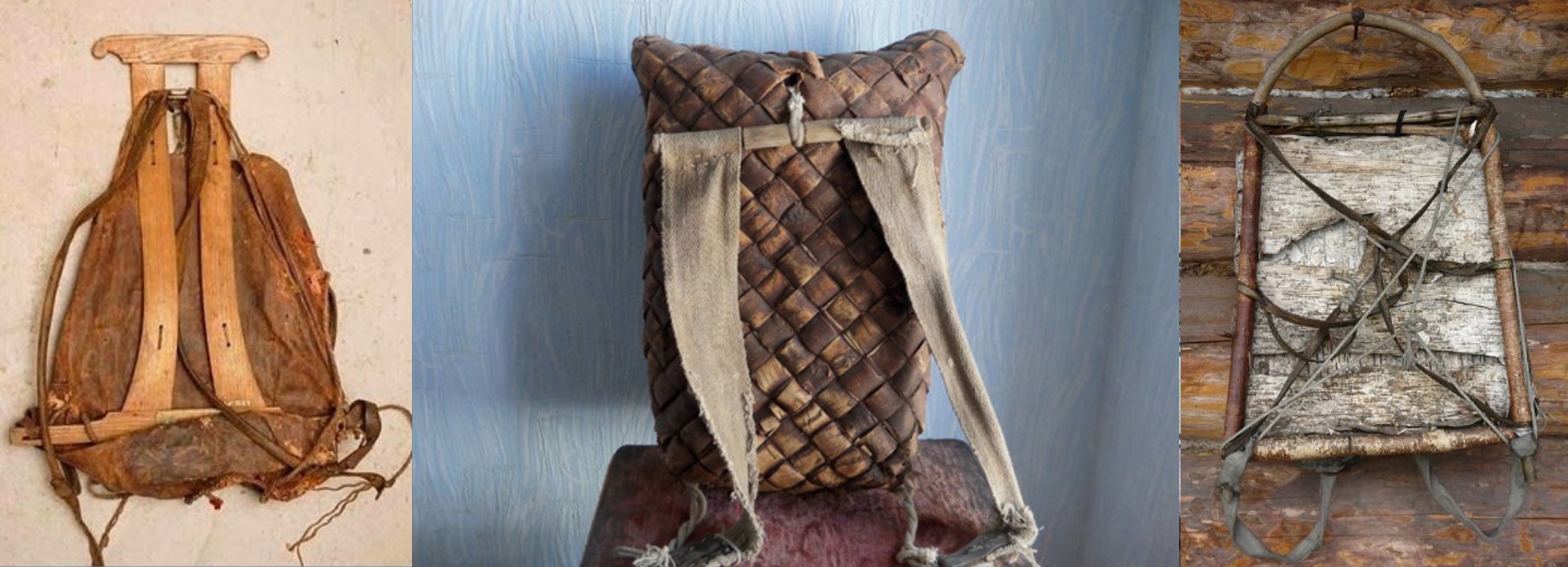
Napoleonic Wars.
Infantryman's combat backpack was the next stage of development. They appeared in Europe in the second half of the 18th century. It was a leather bag of rigid construction with two straps, sometimes with a belt strap. The backpack of such design was lightweight, durable, and not soaked, and more convenient to use than bags with a single strap. It became especially popular during the Napoleonic Wars, and later in the Russian Empire's army.
Reproductions of paintings. Infantry units of the Russian Imperial Army and the Great Army (Armed Forces of the French Empire under Napoleon Bonaparte).
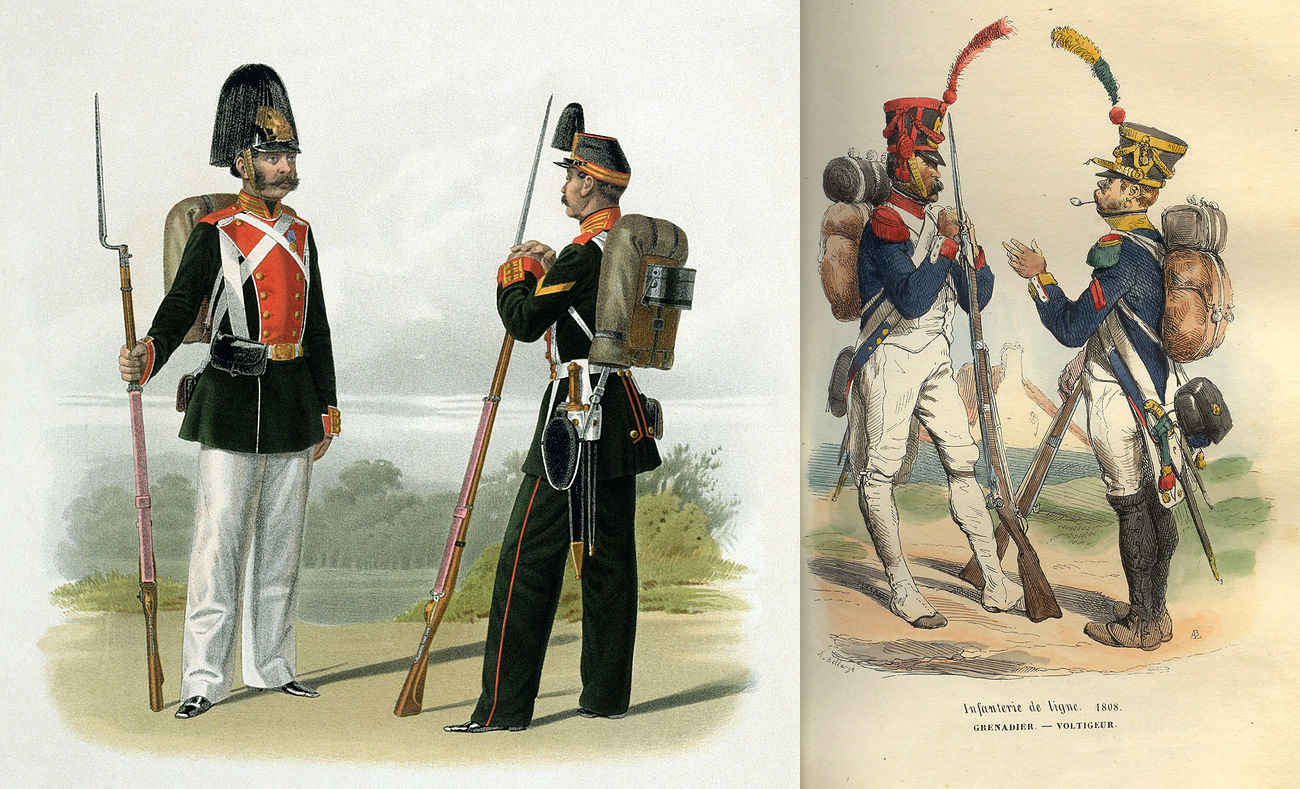
First and Second World Wars, Interwar period.
Approximately in this condition it existed until World War II. Although. Many units of the Wehrmacht, Soviet Army and others continued to use such packs later, but new technologies and needs showcased new possibilities. Canvas duffel bags, in which only leather was used on the straps, became increasingly popular. The canvas is strong, much cheaper in production, has less weight, and when treated with special substances had waterproof properties not worse than the leather. Their ergonomics allowed you to easily fight without taking off your backpack, or easily get rid of it if necessary. So towards the end of World War II, most of the armies changed combat backpack to duffel bags.
Winter and summer single-stage infantry soldiers of the Austrian Landwehr in the middle of World War I.
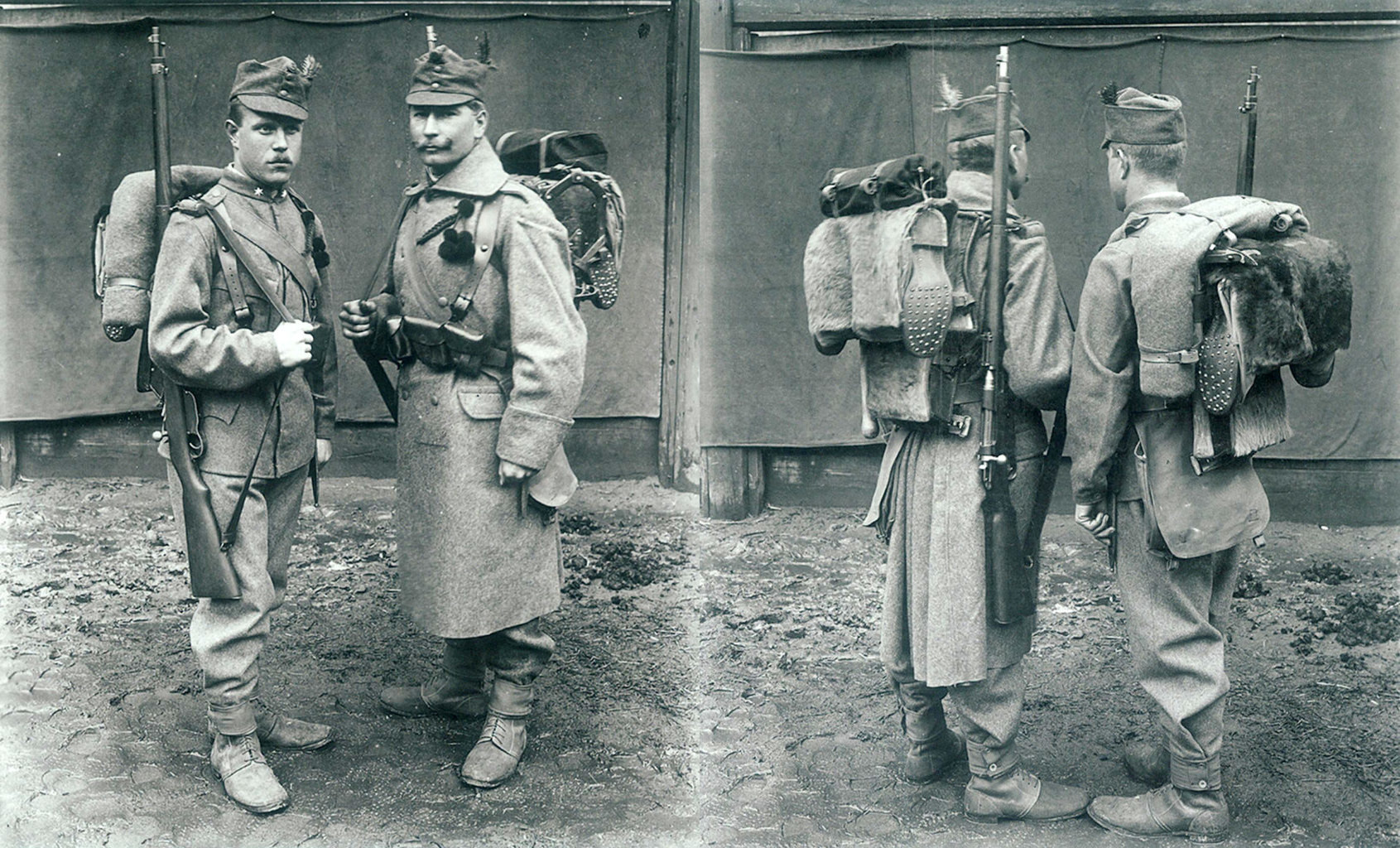
Tourist backpacks were also developed together with the military. Obviously, the first frame backpacks began to produce for tourism and tourism-commercial purposes. This is the beginning of the last century in the U.S., during the "Golden rush". Travelers needed reliable backpacks, which are easier to carry large loads in harsh conditions. That's where this technology was needed. Frame backpack helps to redistribute the weight from shoulders and back to the area of the lumbar, pelvis, legs; they are also more practical – it is easier to attach any cargo on the frame.
Prospectors overcome the mountain pass Chilkut. Monument to the prospectors in the town of Scaguay in southeast Alaska.

Backpacks of wireframe type in the armies began to appear with the outbreak of World War I, during the battles in the mountains. They had a metal frame, canvas bag with leather elements (in the fixing points) 50-60 liters. Such models were equipped with mining and field units, which carried out separate operations independently, being away from supply bases. The Germans and Italians were the innovators in such combat operations. At the same time, the Soviet troops also had mountain assault units, but they were more modestly equipped and had almost no frame systems.
Modern reconstruction of the first frame backpacks, which were provided by the U.S. Army V-1942 (left), and Germany Sturmgepäck (right), during World War II.
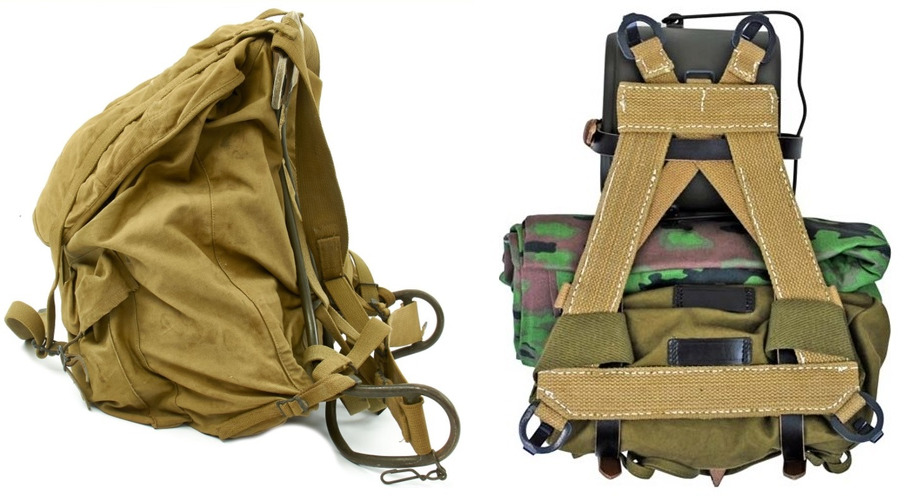
Cold War.
The breakthrough in this area (as in many others) took place in the 50-60s – during the creation and introduction of synthetic materials, the most important of which is Nylon! Lightness, durability, versatility in use, watertightness and speed of drying exceeded the indicators of leather and canvas by several times, the design and implementation of suspension regulation systems began. Thanks to these high indices the production of tourist backpacks of large volume from 60 to 80 and even up to 100 liters began. Military backpacks of large volumes were also produced, but a little in a different direction.
The most striking example here is the U.S. Army backpacks during the Vietnam campaign. The most famous of them are Tropical series backpacks. At first they were strong, lightweight nylon waterproof and fast-drying backpacks of a special design, later the detachable modules began to appear, and in the mid-sixties the first flagship of modular frames was designed. Anything could be attached to such frames: a bag, a radio, mortar and grenade charges, etc.
The photo shows the Vietnam campaign period backpacks: Tropical (sometimes Jungle) rucksack (left) and the modular frame Lightweight rucksack (right).
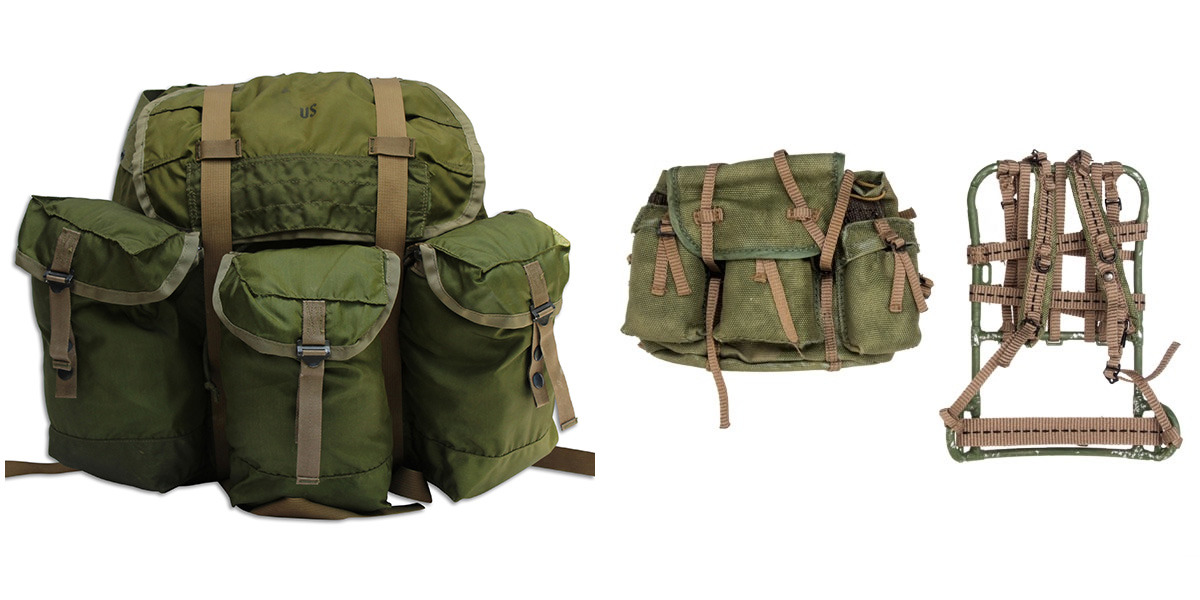
At the end of the war in Vietnam, the U.S. army adopted a new system of equipment attachment A.L.I.C.E. – All-Porpose Lightweight Individual Carryng, which consisted of a modular frame backpack, as well as a new system for fastening bags with metal clips.
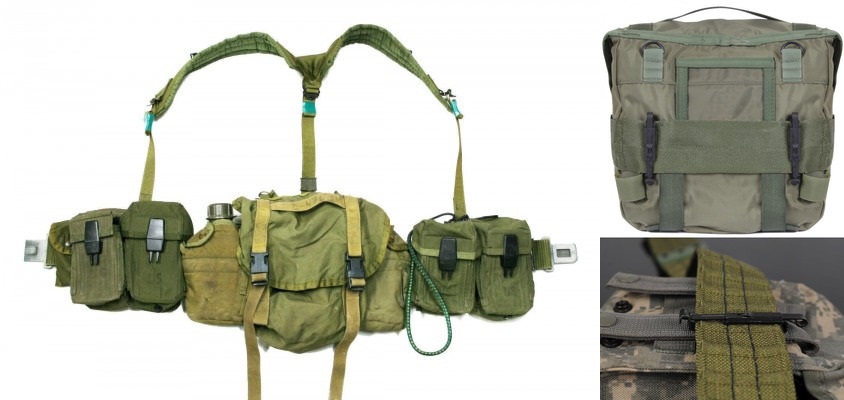
Soviet military backpacks. Alpine assault of Soviet Army units used backpacks similar to tourist "Abalak", landing units were equipped with assault backpacks (RD-54) and unloadind system of 1954 model until the collapse of the Soviet Union, infantry units were equipped with "Sidors".
The photo shows the backpack of the paratrooper model 1954 and the unloading system to it (RD-54).

Tourist backpacks in the Soviet Union sewn from the same materials as the army, the most popular of them were "Abalak", the design of which came up with the famous Soviet climber Vitaly Abalakov, options for a simple "Sidor", "Kolobok", "Backpack Yarova".
Backpack "Abalak", sufficiently spacious, had comfortable side pockets, but still without a belt and a hard back.
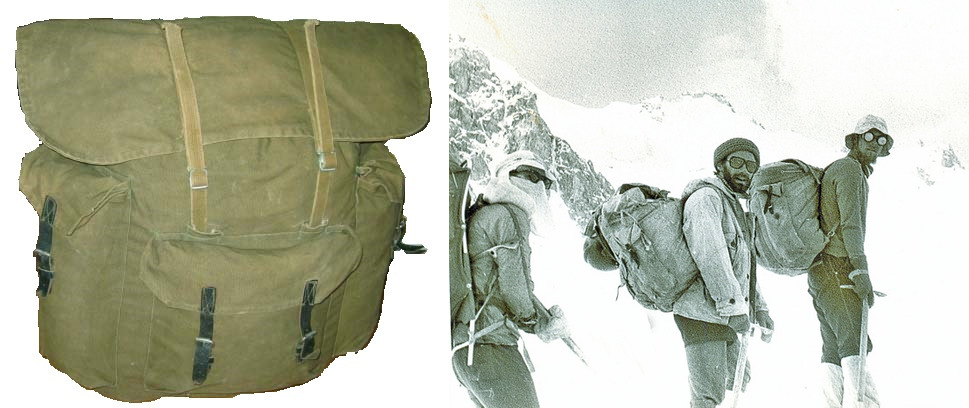
About the "technology" of such backpacks is easy to guess: canvas bag, leather straps and fasteners, spacious enough, because of the impregnation of special substances, such bags are not wet and do not burn.
From left to right: "Sidor", "Kolobok", "Backpack Yarova".
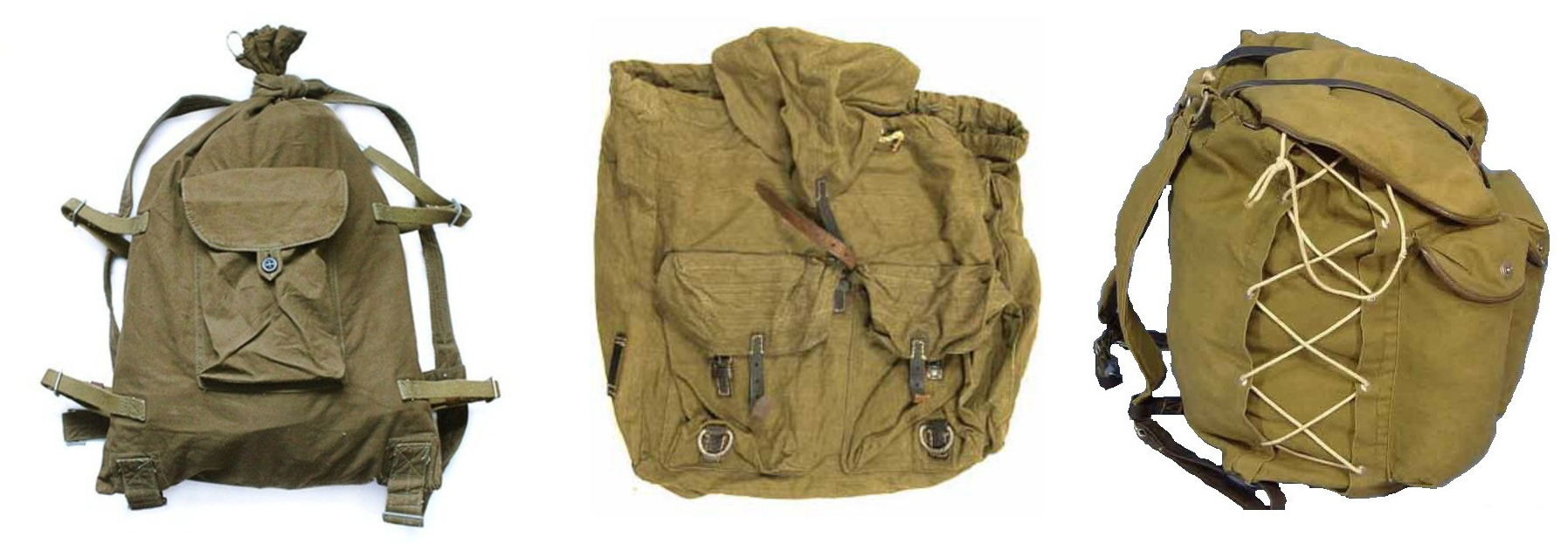
In the 70's the first real easel backpack "Ermak" appeared, which was obviously a more uncomfortable copy of one famous Western models.
On the right picture is the first Soviet frame backpack "Ermak" 70s, on the left is the famous model of the company Kelty 1963.
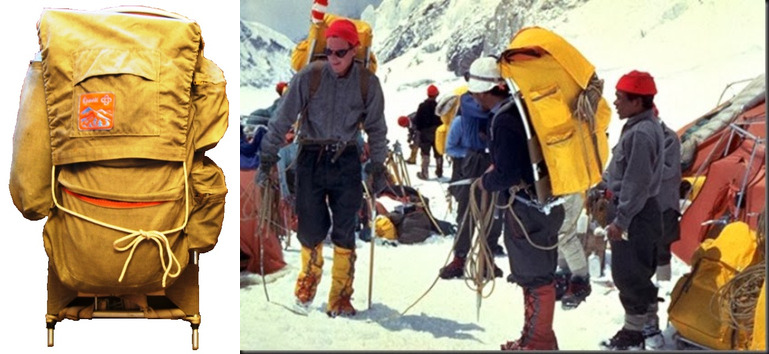
Professional tourists of all-Union and international level were equipped exclusively with imported equipment of German, American (etc.) production. And ordinary tourists usually did not have access to such equipment, so they used what they had – old army backpacks, or self-made models.
The next significant contribution to the development of military backpacks was made by British designers. During the Falkland War in 1982 they designed the legendary Bergen backpack, which in its design had a completely new modular system for fixing bags P.L.C.E. – Personal Load Carrying Equipment. This design was how successful it was that most NATO armies began to develop backpacks based on it.
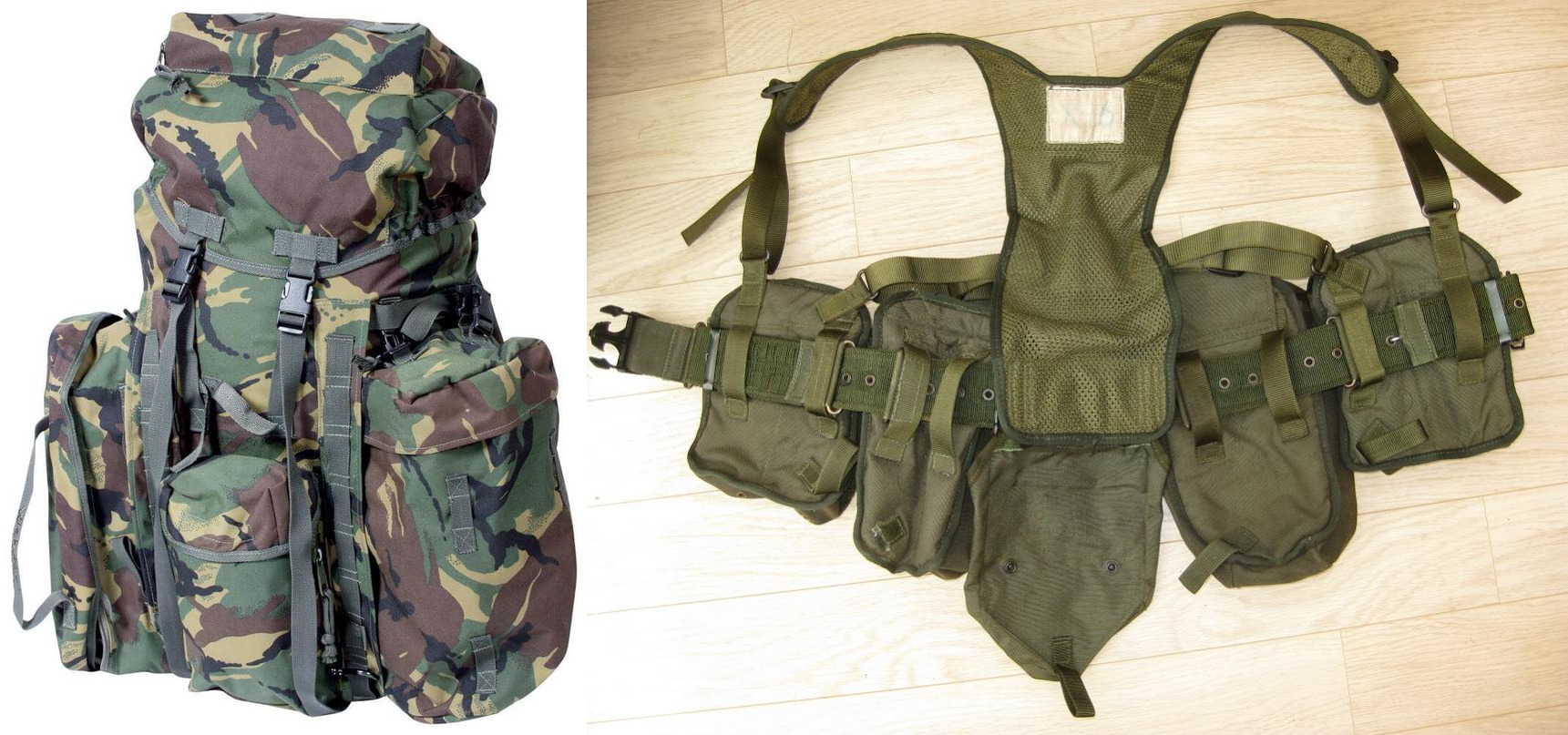
Modernity.
The next and for today the last big breakthrough in backpack making was made in the late 1990s by two american companies Blackhawk and Eagle. Both brands were founded by retired Special Forces soldiers, who by their own experience knew what they want from a backpack and why they were not satisfied with a standard army A.L.I.C.E. These companies began to produce comfortable, very ergonomic backpacks from reliable, exclusively military materials, which have become popular with the military.
These companies were the first to start producing backpacks designed for the specific use of individual units or combat units. For example, a special backpack was created for walkie-talkies, snipers, medics and the like. Also, these companies were the first to produce special modules-drinking CamelBak systems, with which the fighters had a stock of water, which did not hinder their movement (flexible plastic tank was mounted inside the backpack). Technologies of these manufacturers were amazed both military and other manufacturers, who began to make copies of brands Blackhawk and Eagle.

To date, all NATO member states have adopted the new system of mounting, equipment – M.O.L.L.E. (Modular Lightweight Load-carrying Equipment). It is a system of special nylon cells of standardized size, sewn on all field equipment, including backpacks. This system allows you to personalize and quickly disperse the equipment to suit the needs of any user. In the late 90s and early 2000s, the system was introduced and adopted by the U.S. Army, later by NATO and its allies. Today, it is a standard standard equipment of NATO and its allies – any U.S. pouch can be hung on the backpack of Germany, Britain or Japan. In early 2015, the implementation of the M.O.L.L.E. equipment attachment system in the Ukrainian Armed Forces began.
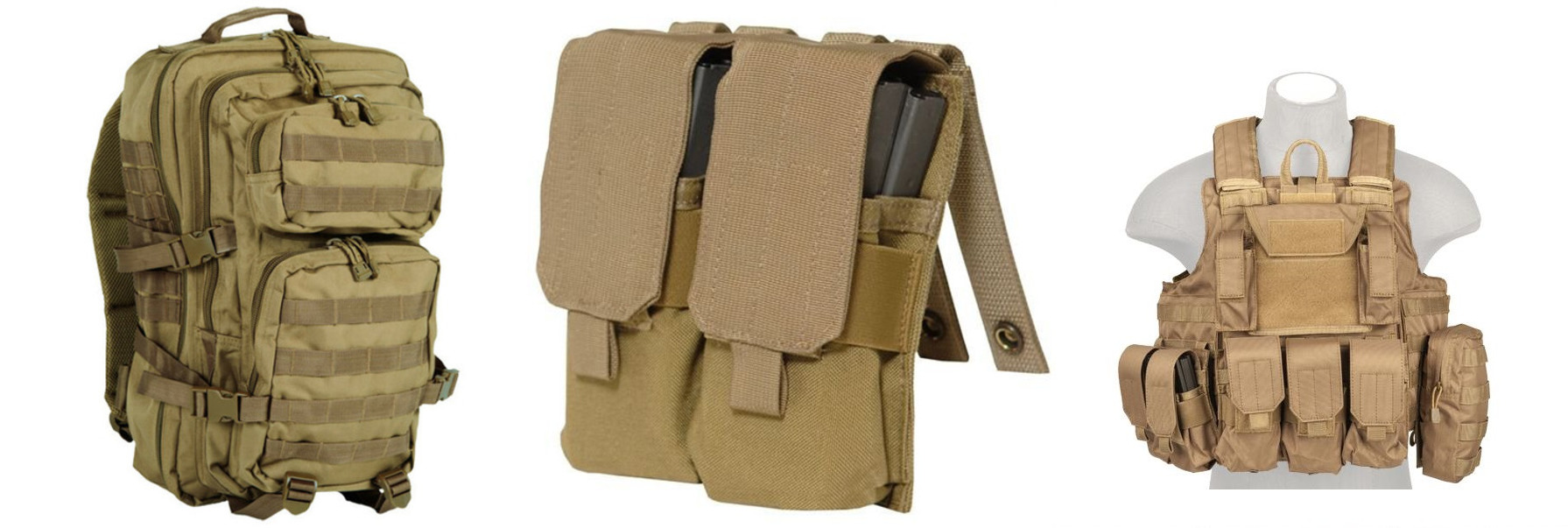
How to choose a quality backpack.
Pay special attention to the materials and fittings!!!
Materials. A quality backpack should be made of nylon! Polyester backpacks, although they look like nylon backpacks, still have several times less tear and abrasion indices, which is very important for the performance indicators. For example, if nylon CORDURA 1000D® have about 300 kg in the laboratory tear test, the polyester fabric shows less than 100 kg. The situation is similar with the wear resistance tests. In addition to its strength and reliability, nylon is perfectly shaped, water-repellent and dries quickly.
Fittings. The main materials for fittings today are POM and Nylon. POM – quite reliable, inexpensive, durable material, on the fracture withstands heavy loads, but in low temperatures can lose its properties, which often leads to failure. Nylon – easily endures all conditions and temperatures, durable – no plastic part by hand you can not break, but such fittings are times more expensive than POM.
In the production of military backpacks, special attention is also paid to materials and fittings, but their type for the Ministry of Defense or other appropriate body, due to the fact that in addition to the high rates of tear and wear resistance, there are also some other requirements for the materials, the most important of which is the flame resistant and reflection in the IF spectrum of some types of nylon, here are used only those types that have a camouflage effect in the IF range (NIR), which is very important for the performance of combat missions in the dark. Today, not all manufacturers of even the highest quality equipment can boast of contracts with certain armies of the world.
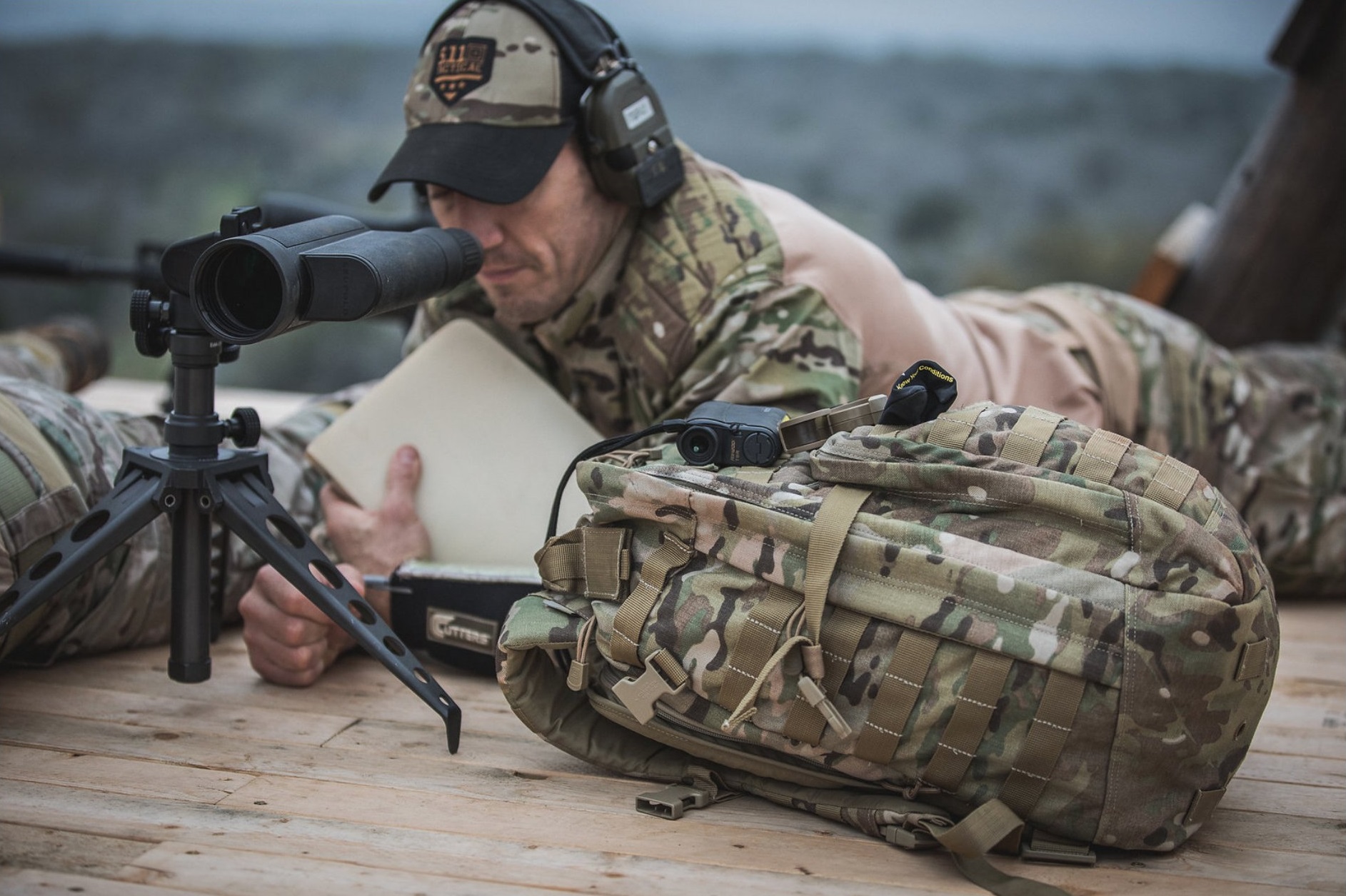
Firm manufacturer.
Today, there are quite a few well-known brands that make good, reliable backpacks, and if you do not want to ponder over the details, then buy a backpack of a famous brand, choosing the size for your needs. Such brands are usually responsible for their products, use only quality materials, give a guarantee on the product and are certified on various indicators: wear resistance, waterproof, resistant to high and low temperatures. Such certification is carried out experimentally and in two stages: laboratory – well-known manufacturers have their own scientific and technical base, in the laboratory conditions test the reliability of such products. The second stage – field, – working together with various athletes, climbers, travelers, various task forces such manufacturers test the quality of their products with an applied method.
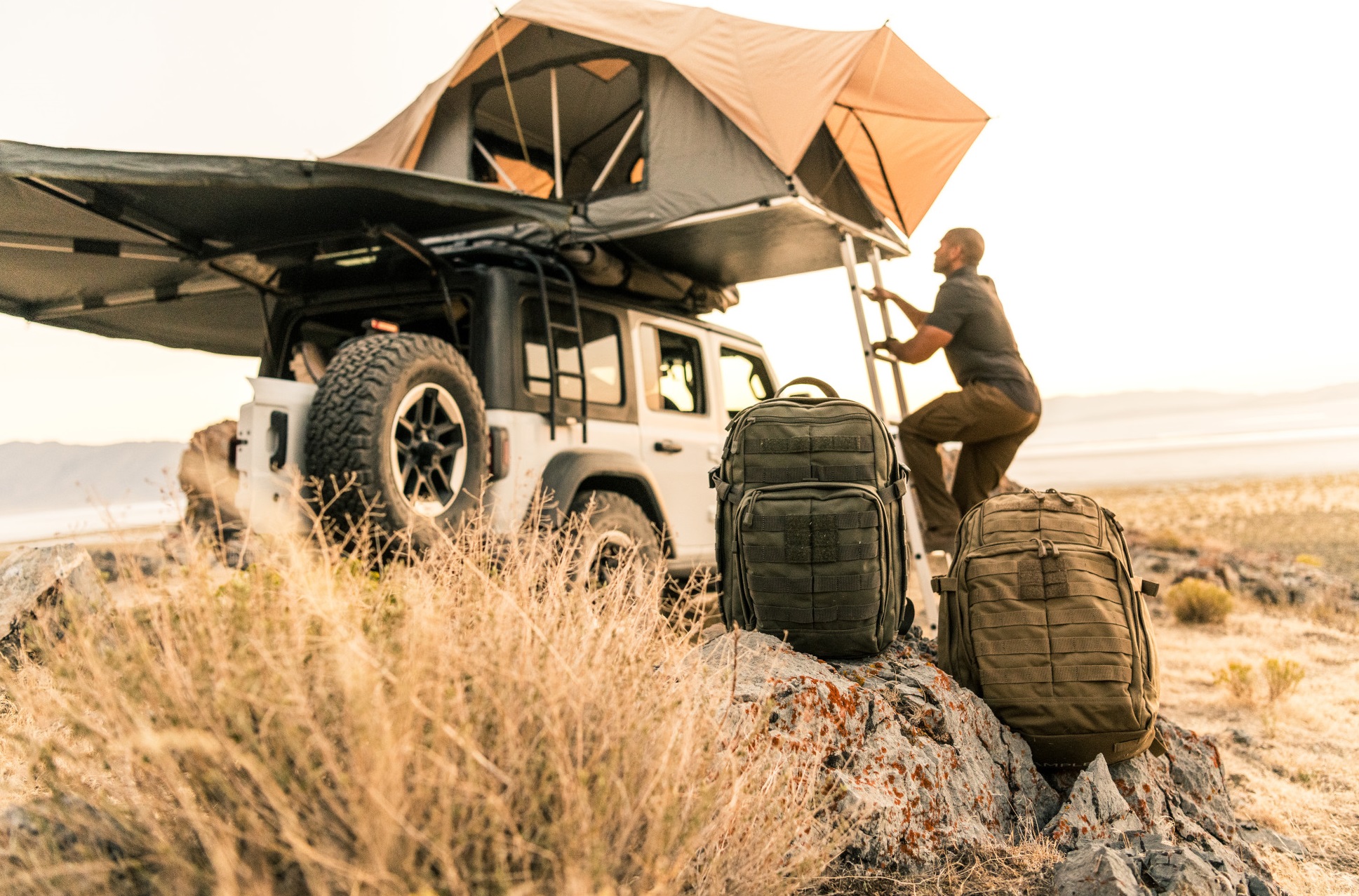
First of all, you need to decide for what purpose you need a backpack. Conditionally, tourist backpacks can be divided into three main types:
- Expeditionary – the volume of 60-100 liters. Backpacks with the volume of more than 80 liters are used by professional sportsmen and travelers in long-term super-complicated hiking tours at any time of the year and weather, high mountain climbs of high complexity and the like. The volume of 60-80 liters is used for the same purposes, but in lighter conditions (weather, geographical, etc.). Experienced professionals can combine different volumes with different conditions, it depends on the number of equipment and its size.
- Medium – without frame, with a rigid or semi-rigid backrest of 30-60 liters. They are used in simple weather conditions, not designed for long trips outside the city. With such a backpack you can easily take bivouac equipment, enough clothes, provisions, etc.
- Small – less than 30 liters. They often have a semi-rigid backrest, but more often the usual soft back. Mostly used for short walks – a maximum of one day, sometimes with overnight stay. Also for long hikes can be used as auxiliary for radial walks.
The specifics of using backpacks by the military and tourists are similar, although the cargo they transport differ both in composition and weight. Their appearance is also different.Often tourists in traveling use military backpacks, but not vice versa, no serious manufacturer of tourist backpacks will not recommend the military to use their backpacks for combat missions, except for the transport and storage of personal belongings.
The military backpacks are roughly similar in type to tourist backpacks.
- Large – 60-100 liters, – usually used for combat missions at a distance from support bases, or when large loads need to be transported to carry out tasks. Very often such a backpack is left in the place of the completed task, due to the inconvenience of transportation and short time.
- Medium – 30-60 liters, some of which are called three-day backpacks, because such backpacks are often used for tasks that require a maximum of three days' distance from the support bases.
- Small – less than 30 liters, – for radial outputs or to carry important things.
For example, the design features of one of the most famous tactical backpacks – 5.11 Tactical Rush 100 Backpack.
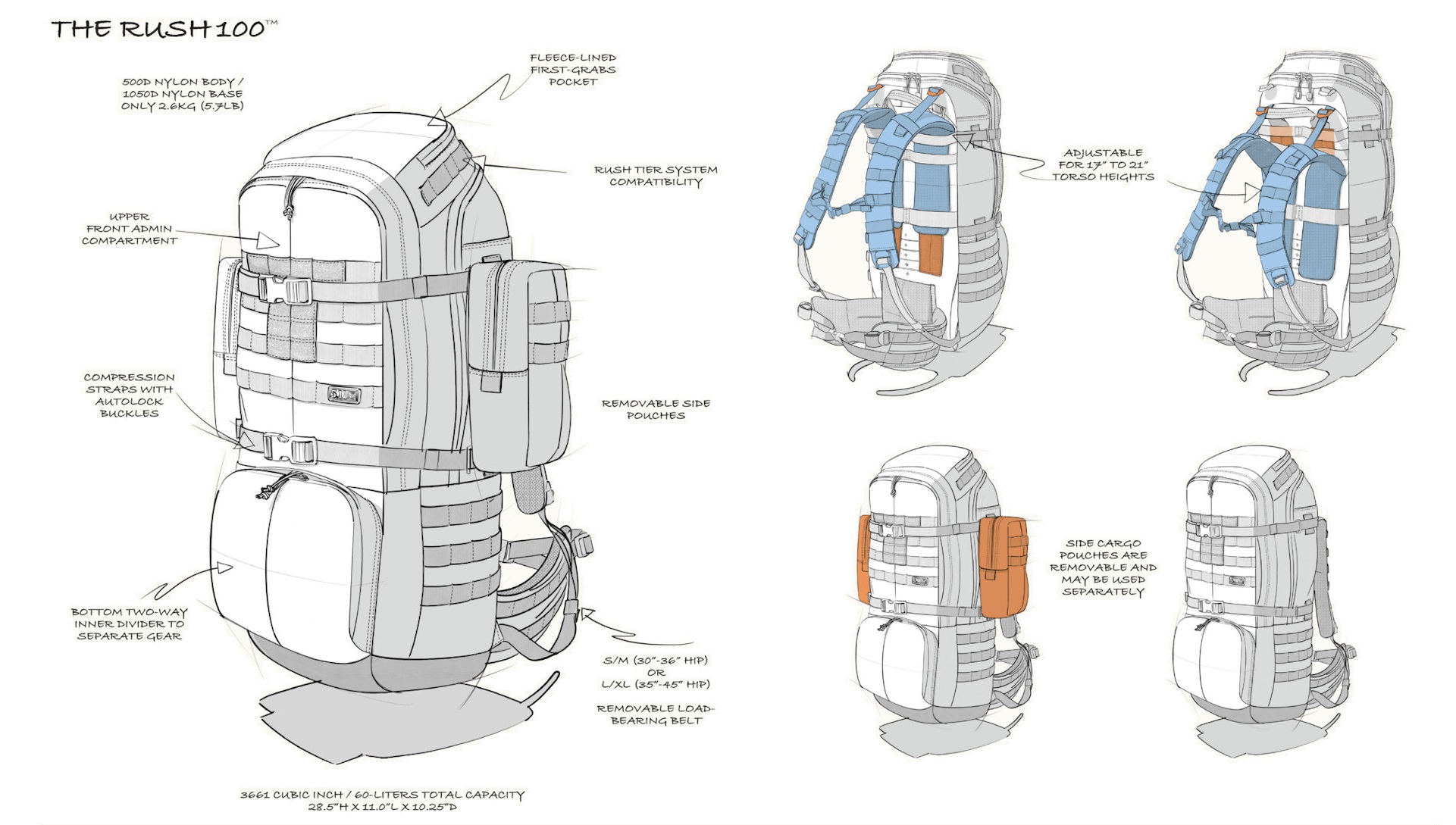
Recently, many manufacturers have started sewing rucksacks in the militaristic style, but they should not be confused with the military. First of all, they are distinguished by materials, which in military backpacks are confirmed by the Mil-Spec standard. Also an important criterion is ergonomics and practicality, because it is the military backpack is tested and you can be sure that it will withstand all the loads and will not hurt your back.
To sum up, please note that when you choose equipment from well-known brands that are responsible for quality, reliability and your comfort in use – your journey will be as comfortable as possible in all conditions. You can rely on such things, and another important fact is that such a backpack will last a long time, will pay off the invested money and will leave only pleasant feelings.
If you buy "No Name" of unknown origin, sewn from unknown, but obviously of poor quality materials, but bought at a "good" price, and has an interesting design, we do not recommend you to go with such a bag on journeys of high complexity, in which the unpleasantness of the level of coming into the trash backpack can be fatal.


